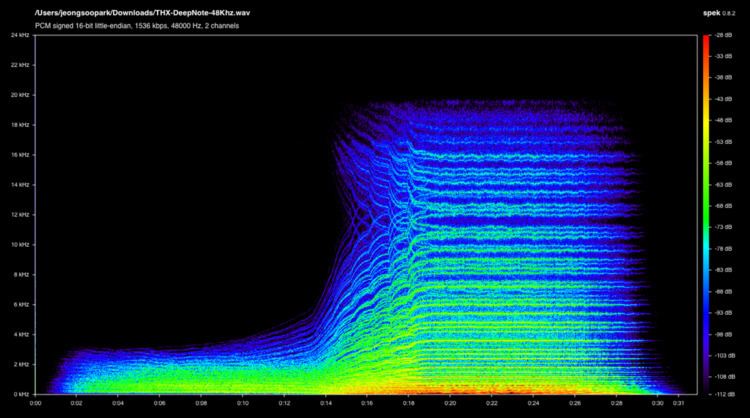 | ||
The Deep Note is THX's audio trademark, being a distinctive synthesized crescendo that glissandos from a low rumble to a high pitch. It was created by Dr. James A. Moorer, a former employee of Lucasfilm's Computer Division in late 1982. The sound is used on trailers for THX-certified movie theaters, home video, video games, and car infotainment systems.
Contents
- Description
- Lucasfilm version 1983 2015
- Regenerated version 2015 present
- Previous works
- In popular culture
- References
The Deep Note debuted at the premiere of Return of the Jedi in Los Angeles. Since then, it has gone on to be a pop culture icon both in meme and cult nature, and had been redesigned and rerecorded for the 2015 "Eclipse" trailer.
Description
The U.S. trademark registration for the first version of the sound contains this description of it:
The THX logo theme consists of 30 voices over seven measures, starting in a narrow range, 200 to 400 Hz, and slowly diverting to preselected pitches encompassing three octaves. The 30 voices begin at pitches between 200 Hz and 400 Hz and arrive at pre-selected pitches spanning three octaves by the fourth measure. The highest pitch is slightly detuned while there are double the number of voices of the lowest two pitches.
Lucasfilm version (1983-2015)
The first version of the Deep Note made its debut before the first THX trailer, Wings, that preceded the premiere showing of Return of the Jedi. Two different interpretations of the note ran concurrently with the 1983 version in both the Grand trailer and the mid-90s reorchestration of the Cimarron trailer. The Deep Note originally transitioned from a soft to loud intensity, and over the years has been remixed digitally, as new technology developed. In 1993, the Deep Note was cut short and pitched higher (ending in an E chord rather than a D), to save time for Laserdisc and again in 1995 for VHS. In 1996, with the debut of Tex, the Deep Note was low-pitched and cut short which is different than other versions. It was later used in the DVD version of the digitally mastered variant of the iconic Broadway trailer in 1997, then later with both the Ziegfeld and Tex Action trailers in 2006. In 2007, for the Amazing Life trailer, the Deep Note had been cut short to the single note (where both sounds stay in one pitch), in favor of other sound effects. However, in the last two trailers to use the 1983 note, both based on the famous Broadway trailer, the sound was played in full.
The sound is perceived as louder than it actually is; sound designer Gary Rydstrom explains that, "from a technical standpoint, 'Deep Note' just feels loud because it has a spectrum of frequencies that grows from small to large."
James A. Moorer said in a 2005 interview, "I like to say that the THX sound is the most widely-recognized piece of computer-generated music in the world. This may or may not be true, but it sounds cool!"
Although Moorer had initially claimed that the score consisted of about 20,000 lines of code, he subsequently corrected the statement and elaborated:
The original 30-year-old C program is 325 lines, and the “patch” file for the synthesizer was 298 more lines. I guess it just felt like 20,000 lines when I did it.
Given that it was written and debugged in 4 days, I can’t claim the programming chops to make 20,000 lines of working code that quickly. But, to synthesize it in real time, in 1983, took 2 years to design and build a 19” rack full of digital hardware and 200,000 lines of system code to run the synthesizer. All that was already done, so I was building on a large foundation of audio processing horsepower, both hardware and software. Consequently, a mere 325 lines of C code and 298 lines of audio patching setup for the 30 voices was enough to invoke the audio horsepower to make the piece.
Regenerated version (2015-present)
In April 2015, THX introduced a new trailer named Eclipse, which is accompanied by an updated, more powerful version of the Deep Note, also created by Moorer. It is described as being "intensely more complex, taking the audience on an epic sensory journey unlike anything they've experienced before." This version of the Deep Note was created entirely digitally so it could play on Dolby Digital 7.1 and Dolby Atmos systems, and Moorer created 30-second, 45-second and 60-second versions of it. Moorer used around eighty voices in the remake, as opposed to thirty in the original 1982 version. In an interview with Yahoo, Moorer said "I kept thinking: That’s the way I wanted it to sound originally. I think it’s as far as you can take it."
Previous works
Prior to the creation of the Deep Note, several other works made use of similar techniques of frequency spread.
In their book Analog Days, Trevor Pinch and Frank Trocco point to the track "Spaced," from the 1970 Beaver & Krause album In a Wild Sanctuary as the source for Deep Note. They quote synthesizer builder Tom Oberheim as saying the original analog form is much richer than the "digital perfection" used in movie theatres.
Another recognized predecessor to the Deep Note is a part in the song by The Beatles, "A Day in the Life", using a full orchestra. However, unlike the Deep Note, the resolving high chord is never held, but instead brought to a stop. Moorer has admitted that both "A Day in the Life" and a fugue in B minor by Bach were sources of inspiration for the Deep Note.
A very similar sound occurred in the Styx song "Krakatoa" on their album The Serpent is Rising, as well as in the soundtrack to the 1979 movie When a Stranger Calls.
In popular culture
The perceived loudness of the Deep Note is frequently depicted as having actual destructive effects:
